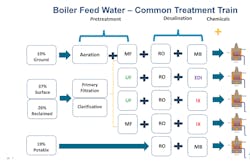Power plant wastewater streams: Efficient and effective treatment management
Every industry has an urgent need for water and effluent treatment, as access to water has been a constant — and worsening — issue globally. One sector that is notorious for its copious water consumption is the power industry, alone responsible for 41% of daily water withdrawals. This data makes one truth apparent: this industry is impacted immensely by limited water resources, drought and even, tightened regulations.
In addition to dwindling access to water, the power industry has been grappling with strict effluent discharge regulations since September 2015. Seven years ago, the U.S. EPA passed a new regulation for power plant wastewater discharges, which includes all team-electric power plants over 50MW in capacity (Source, EPA). This regulation — along with the worsening water shortage — has driven many organizations to seek new, advanced technologies.
In the power industry, there are three main streams that require treatment: boiler feed/makeup water, cooling tower makeup and cooling tower blowdown. Here is a closer look at the various streams.
Boiler feed/makeup water
Boiler feed/makeup requires high-quality water (ultrapure water), and is treated to remove nearly all dissolved solids, control alkalinity, prevent scaling, correct pH and control conductivity. Advanced treatment of boiler feed water is a necessity, and the manufacturers clearly define the water parameters for this high-quality water.
Proper boiler feedwater treatment allows for preservation of steam quality, boiler efficiency and equipment, given that the quality of the feed water has a direct impact on the quality of your steam. Historically, boiler shutdowns are tied directly to poor feedwater treatment, yet it is not always a straightforward process.
Boiler feedwater treatment varies depending on the source of feed water, and typically includes necessary stages of filtration, reverse osmosis and a final stage of mixed beds (MB), electrodeionization (EDI) or ion exchangers (IX). In Figure 1, you will see the typical treatment of boiler feed/makeup water, according to the source of the water.
Cooling tower makeup
In cooling tower makeup, water is added to the cooling tower system regularly, offsetting the lost water due to evaporation, drift and blowdown. The goal of this treatment is to maintain optimal system operation and process control.
Traditionally, cooling towers are more forgiving than boilers when it comes to the water they tolerate. The most common water sources for cooling tower makeup are surface water, well water and seawater. However, as the common water sources are dwindling, power plants are looking to municipal wastewater, which requires more advanced treatment.
Those handling this process must keep two things in mind: “what goes in, must come out” and the Opex of the facility. Chemicals can be used on the feed prior to entering the cooling tower, but detrimental issues may arise, such as handling hazardous material, transportation and storage of chemicals. If those problems come to fruition, facilities may be saving on the water treatment going in, but the treatment of the blowdown can be extremely complex and costly.
There are major benefits to using treated water for makeup, given that it minimizes the maintenance of the cooling tower. The treatment of cooling tower makeup water varies based on the source of the water, and can include ultra-filtration, activated carbon, multimedia filtration, reverse osmosis, closed-circuit reverse osmosis, ion exchange softening, electrodialysis reversal and chemical conditioning.
Cooling tower blowdown
The cooling tower blowdown treatment involves cycling and evaporating of cooling tower water, resulting in concentration of total dissolved solids (TDS) and scaling ions. This results in the need for periodic “blow down” of the cooling tower water and its replacement with fresh water. In order to reuse the water and to comply with regulations, this cooling tower blowdown (CTBD) wastewater calls for recirculating cooling.
This is likely the most complex stream to treat in the power industry. When water evaporates from the tower, dissolved solids — such as calcium, magnesium, chloride and silica — remain in the recirculating water, with the concentration of these dissolved solids increasing as more water evaporates. If the concentration gets too high, the solids can lead to formation of scale within the cooling tower and potential corrosion issues. This is called the concentration cycle — and more cycles before blowdown result in lower water consumption and less generated water volume. Due to the risk of corrosion and scaling inside the cooling tower, the concentration cycles cannot be increased to infinity.
Also, there comes a point when the concentration cycles are no longer efficient. The cycles need careful monitoring, as does control of the quantity of blowdown to reduce the amount of water and blowdown. However, there is still a substantial blowdown stream to treat, and it comes with very complex chemistry. With worsening water shortage and stricter regulations for power plant wastewater treatment, highly advanced technologies are regularly being developed to meet industry needs in this area. Some power plant wastewater treatments can include targeted removal of specific contaminants such as scaling ions or chlorides, all the way to high recovery or zero liquid discharge treatment, to produce a low volume of brine, or even solids.
The bottom line
Most power plants relied on surface water for their water needs from 2000 to 2009. Yet, there has been a drop in the use of surface water in the last decade — and an increase of more than 100% in the use of reclaimed water. With a significant increase in the use of advanced water treatment in power — not only due to the need for regulatory compliance, but also due to the decrease in the quality of the feed water — the water chemistry of cooling tower blowdown has become undeniably complex. Treating this stream using conventional systems faces hard-to-manage-challenges, such as high Opex and the inability to reach high recovery.
Inbal Oferber is an industrial solution manager at IDE Technologies.

